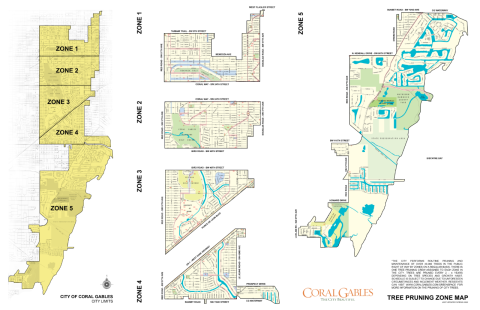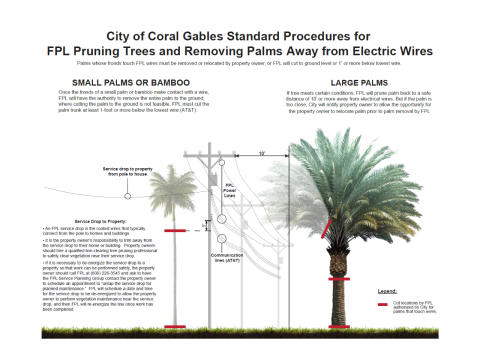Tree Guide
Identify the trees growing around Coral Gables and South Florida with a useful visual guide.
Tree GuideTrees within City Swale
Pruning Schedule
The city conducts tree pruning services according to industry standards that are tailored to zones and species of trees. The pruning cycles can vary from 18 to 48 months depending on the tree species. In cases where residents want to prune city trees off-cycle, the city offers the option to the residents to pull a no-fee Right of Way Tree Pruning permit and hire the services of a full tree service company with ISA Certified Arborist on staff.
Residents may request service through the citizen request center for emergency-related situations only.
Emergency situations include but are not limited to:
- Broken and hanging branches
- Falling and fallen trees
- Traffic light and sign obstruction
Pruning Zone Map

Tree Trimming Over Property Lines
Trees and vegetation that cross into your property from an adjacent property may be properly pruned within your property. Pruning of trees may also be done by the property owner with assistance as needed by assisting labor. The city does not perform any work on trees inside private property.
Your Trees on Private Property
Please note the City Code states residents do not need a permit to prune their own trees inside their own private property unless they are going to remove more than 25% of the tree canopy or branches larger than 10” diameter. If more than 25% of the tree canopy or branches larger than 10" diameter is going to be pruned then the resident should hire a ISA certified arborist to supervise the pruning (a qualified tree trimmer) so the trees are pruned properly and to standards.
Pruning of branches larger than 4” in diameter should be supervised by a qualified tree trimmer knowledgeable of ANSI (American National Standards Institute) tree pruning standards, such as a certified arborist. Removing larger branches improperly could cause harm to a tree if not performed by following ANSI pruning standards.
Please read the City Code to ensure the proper management and pruning of trees to avoid penalty. And see below for an explanation of standard tree protection.
Tree Protection Standard Details [PDF]Tree Pruning on Power Lines (FPL)
There are three different ways for FPL customers to report these conditions immediately:
- via FPL website,
- via phone: 1-800-226-3545, or
- via the FPL App: Power Related Concerns/Tree Trimming Investigation Request
When either of these reporting mechanisms is used, FPL has the ability to monitor each of these requests with all of the appropriate resources. See the following documents below for more information:
- City of Coral Gables Standard Procedures for FPL Pruning Trees and Removing Palms Away from Electric Wires [PDF]
- City of Coral Gables Standard Procedures for FPL Pruning Trees and Removing Palms Away from Electric Wires (Español) [PDF])
- Coral Gables and FPL Tree Management Workshop [PDF]
- Watch the FPL and Coral Gables 2019 workshop here.

Black Olives Study
The Black Olive or Oxhorn Bucida tree, Bucida buceras, is a widespread species found in the south Florida urban forest. Approximately 20% of the total shade trees in public areas of Coral Gables are Black Olive trees. These shade trees are commonly attacked by two arthropods, an eriophyid mite, Eriophys buceras, and a caterpillar, Garella nilotica. By-products of these pests such as caterpillar frass and mite-induced galls cause severe staining of sidewalks, streets and vehicles underneath the tree canopy.
The staining is so aesthetically problematic that dissatisfied homeowners wish to remove the trees. Residents can remove this staining by scrubbing the affected pavement or structure using a diluted mixture of household bleach and water as a temporary solution.
Studies were conducted by The Davey Institute over a 4-year period in Naples and Coral Gables, Florida to evaluate insecticide treatments against these pests. During 2015 and 2016 in Coral Gables, abamectin trunk injections resulted in excellent reduction in gall formation and staining. Abamectin trunk injections are proving to reduce the staining to property, and preserve the positive environmental benefits of mature Black Olive trees in the urban forest. This represents an environmentally rational approach with none of the drawbacks associated with foliar applications or soil drenching.The City of Coral Gables performs treatment injections of 2000 Black Olive trees every March and April during the peak season for mite and caterpillar activity.
In order to request tree treatment in public city swales, contact PWGreenspace@coralgables.com or phone 305-460-5000.
For additional information on Black Olive tree treatment, please view the
Davey Institute's Black Olive presentation
